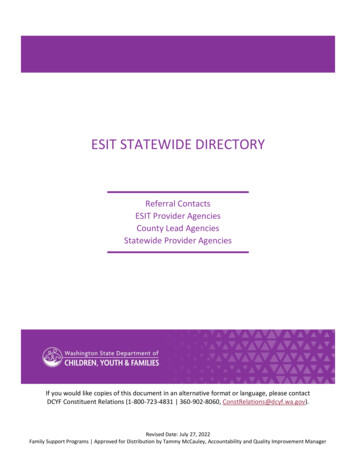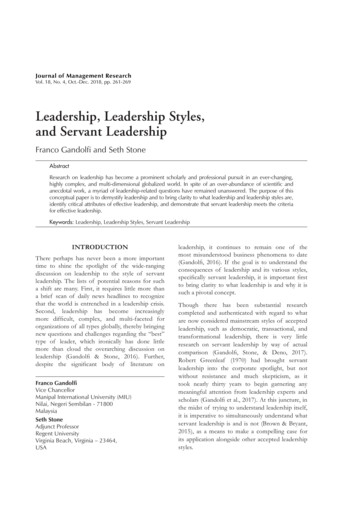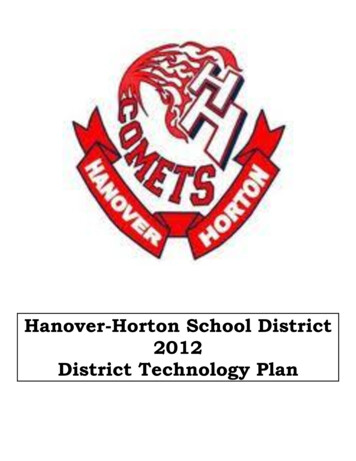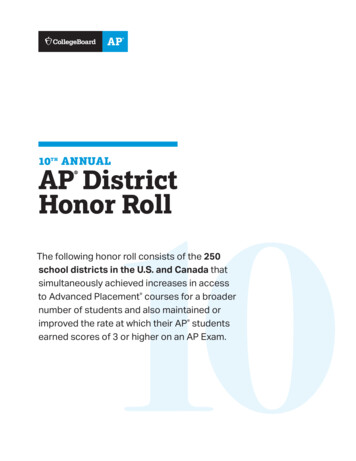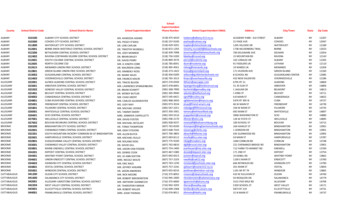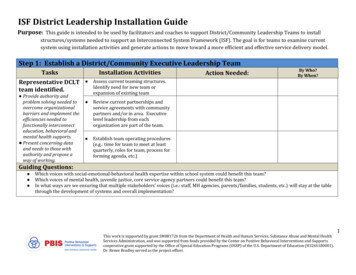
Transcription
ISF District Leadership Installation GuidePurpose: This guide is intended to be used by facilitators and coaches to support District/Community Leadership Teams to installstructures/systems needed to support an Interconnected System Framework (ISF). The goal is for teams to examine currentsystem using installation activities and generate actions to move toward a more efficient and effective service delivery model.Step 1: Establish a District/Community Executive Leadership TeamTasksRepresentative DCLTteam identified. Provide authority andproblem solving needed toovercome organizationalbarriers and implement theefficiencies needed tofunctionally interconnecteducation, behavioral andmental health supports. Present concerning dataand needs to those withauthority and propose away of working.Installation Activities Assess current teaming structures.Identify need for new team orexpansion of existing team Review current partnerships andservice agreements with communitypartners and/or in area. Executivelevel leadership from eachorganization are part of the team. Establish team operating procedures(e.g.: time for team to meet at leastquarterly, roles for team, process forforming agenda, etc.)Action Needed:By Who?By When?Guiding Questions: Which voices with social-emotional-behavioral health expertise within school system could benefit this team?Which voices of mental health, juvenile justice, core service agency partners could benefit this team?In what ways are we ensuring that multiple stakeholders’ voices (i.e.: staff, MH agencies, parents/families, students, etc.) will stay at the tablethrough the development of systems and overall implementation?This work is supported by grant SM081726 from the Department of Health and Human Services, Substance Abuse and Mental HealthServices Administration, and was supported from funds provided by the Center on Positive Behavioral Interventions and Supportscooperative grant supported by the Office of Special Education Programs (OSEP) of the U.S. Department of Education (H326S180001).Dr. Renee Bradley served as the project officer.1
Step 2: Assess the Current Status of Mental Health and PBIS Systems in the DistrictTasks2a: Assessing currentsystem structuresusing the PBISImplementationBlueprintInstallation Activities Identifies need and establishes priority for organizationalstructures needed to supportan ISF (e.g. policy, funding,professional development).2b: Conduct a review of current initiatives Identifying and assessingfidelity and outcomes ofinitiatives with focus onalignment and to ensureefficient utilization ofresources Action Needed:By Who?By When?Complete the PBIS District SystemsFidelity Inventory (DSFI)Or State Teams - PBIS StateSystems Fidelity Inventory (SSFI)Identify system structure changesrequired to shift towards anintegrated approach.Use the ISF Initiative Inventory toidentify all social-emotionalbehavioral related initiatives orprogramsOrganize, align, and eliminateinitiatives based upon overlap,effectiveness, relevance, and fidelityDevelop a schedule for ongoingreview of related initiatives (e.g.,quarterly, twice annually)Guiding Questions: What is currently in place that is working (facilitating positive outcomes for youth and families)?What is currently in place that is either a) not being monitored for effectiveness using data, or b) being monitored and deemed ineffective interms of response?This work is supported by grant SM081726 from the Department of Health and Human Services, Substance Abuse and Mental HealthServices Administration, and was supported from funds provided by the Center on Positive Behavioral Interventions and Supportscooperative grant supported by the Office of Special Education Programs (OSEP) of the U.S. Department of Education (H326S180001).Dr. Renee Bradley served as the project officer.2
Step 2 (con’t): Assess the Current Status of Mental Health and PBIS Systems in the DistrictTasks2c. Conduct a staffutilization review Gathering data on currentrole descriptions and actualtime spent on dailyassignments to support futuredecision making on roles andresponsibilitiesInstallation ActivitiesAction NeededBy Who?By When? Identify roles, responsibilities andtime allocation of all staff deliveringsocial-emotional-behavioralinterventions across the continuum Establish a process to analyze currentutilization of staff resources (i.e.:reality of daily tasks/activities to jobdescription)o Resource: Sample - TimeStudy Template Use the Changing Roles of Staff:District Level Discussion Guide tofacilitate develop action steps forrestructuring service delivery model. Identify coaching resources to trainand support shift in rolesGuiding Questions: How are staff responsibilities organized to produce desired outcomes based upon identified priorities?Are staff aware of the impact of student and staff social emotional functioning on academic achievement?This work is supported by grant SM081726 from the Department of Health and Human Services, Substance Abuse and Mental HealthServices Administration, and was supported from funds provided by the Center on Positive Behavioral Interventions and Supportscooperative grant supported by the Office of Special Education Programs (OSEP) of the U.S. Department of Education (H326S180001).Dr. Renee Bradley served as the project officer.3
Step 2 (con’t): Assess the Current Status of Mental Health and PBIS Systems in the DistrictTasksInstallation Activities2d. Review existingSchool andCommunity Data Conduct comprehensive review ofschool data (e.g.: attendance, grades,suspension, expulsion, students placedin restrictive settings, universalscreening data) and community data(e.g.: suicide ideation/attempts,hospitalizations, child welfare contacts,juvenile justice interactions) of both riskand protective factor data Cross-system leadership teamconducts a needs assessmentof both school andcommunity dataAction NeededBy Who?By When? Gather family and youth perspectivedata as needed (e.g.: focus groups,surveys)Guiding Questions: What do expanded data sources from both school and community tell us about needs and priorities?How do we adjust our programming beginning with prevention strategies (e.g. strengthening Tier 1, teaching social emotional competenciesacross all academic content) based on specific needs of our community?Step 3: Reaching Team Consensus on a Mission StatementTasksEstablish CommonMission Defines purpose of teamEstablishes goals for workCreates shared vision tocommunicate withstakeholdersInstallation Activities Action NeededBy Who?By When?Conduct a crosswalk of missionstatements comparing to messages inthe ISF approachPrioritize areas of need throughconsensus process.Adopt a current mission statement ordevelop a new mission statement thatbetter defines the vision of anintegrated approach.This work is supported by grant SM081726 from the Department of Health and Human Services, Substance Abuse and Mental HealthServices Administration, and was supported from funds provided by the Center on Positive Behavioral Interventions and Supportscooperative grant supported by the Office of Special Education Programs (OSEP) of the U.S. Department of Education (H326S180001).Dr. Renee Bradley served as the project officer.4
Guiding Questions:What issues/data can your group coalesce around?What is your “why” for your group? How will this mission be communicated to key stakeholders? This work is supported by grant SM081726 from the Department of Health and Human Services, Substance Abuse and Mental HealthServices Administration, and was supported from funds provided by the Center on Positive Behavioral Interventions and Supportscooperative grant supported by the Office of Special Education Programs (OSEP) of the U.S. Department of Education (H326S180001).Dr. Renee Bradley served as the project officer.5
Step 4: Establish District/Community Leadership Team Procedures and RoutinesTasks4a: Selecting andinstalling a universalscreener Reviewing, selecting andestablishing district-wideprocedures for conducting aUniversal screening process toaddress both internalizingand externalizing behavioralneedsInstallation ActivitiesAction NeededBy Who?By When? Research and compare universalscreeners Resources: Systematic Screening Tools:Universal Behavior Screeners Screening Resources Select a screener based upon: i)evidence of each tool; ii) resources(e.g., staff time, technology, cost), iii) fitwith other initiatives and priorities,and iv) readiness and capacity toimplement Establish routines and procedures for(i) conducting universal screening and(ii) collecting, managing, analyzing andsharing data Resources: Universal Screening Timeline Best Practices in UniversalScreening for SEB Outcomes: AnImplementation Guide - ComingSoon Ensure response plan including (i)personnel trained to provideadditional assessments and (ii)continuum of interventions in place toaddress internalizing and externalizingneedsGuiding Questions: What is our current process for identifying students at-risk?What do we need to expand to ensure students with both internalizing and externalizing behaviors are identified?This work is supported by grant SM081726 from the Department of Health and Human Services, Substance Abuse and Mental HealthServices Administration, and was supported from funds provided by the Center on Positive Behavioral Interventions and Supportscooperative grant supported by the Office of Special Education Programs (OSEP) of the U.S. Department of Education (H326S180001).Dr. Renee Bradley served as the project officer.6
What routines and procedures need to be modified to ensure consistency?Step 4 (con’t) : Establish District/Community Leadership Team Procedures and RoutinesTasksInstallation ActivitiesAction NeededBy Who?By When?4b. Establish the Request Identify one request for assistanceprocess managed within single set offor Assistance Processblended teams Identify who (e.g., Tier 2 team leader)will manage the request for assistanceprocess Teach process to all stakeholders (e.g.school staff, community partners,students)Guiding Questions: Is there one or multiple systems and/or request for assistance form(s) in the school for managing requests for assistance across tiers? What are the decision rules for accessing interventions? (e.g. 3 minor infractions to access Check-in Check-out (CICO) intervention) Is the process for making/managing/responding to requests for assistance clearly defined and documented?Tasks4c: Selection process forevidence-basedpractices A protocol, in writing for usein selecting all EBPsInstallation ActivitiesAction NeededBy Who?By When? Identify a formal process for selectingEBPs for installation across all schools Resources: Hexagon Tool (NIRN) Consumer Guide to SelectingEvidence Based Mental HealthServices Protocol to Identify MH EBPSwithin PBIS FrameworkGuiding Questions: Do we have a need for a new intervention(s)?Is the intervention we are selecting a good fit for our system?This work is supported by grant SM081726 from the Department of Health and Human Services, Substance Abuse and Mental HealthServices Administration, and was supported from funds provided by the Center on Positive Behavioral Interventions and Supportscooperative grant supported by the Office of Special Education Programs (OSEP) of the U.S. Department of Education (H326S180001).Dr. Renee Bradley served as the project officer.7
Does the research indicate this intervention has evidence to address our need? Do we have the capacity to implement the intervention, including the resources and supports to implement with fidelity and build capacity forsustainability? Step 4 (con’t): Establish District/Community Leadership Team Procedures and RoutinesTasks4d: Process to monitorfidelity of interventions A written protocol to assessthe extent to which allinterventions are beingimplemented with fidelityInstallation ActivitiesAction NeededBy Who?By When? Use Consumer Guide to SelectingEvidence Based Mental Health Servicesbuild fluency for selectionGuiding Questions: When and how often will the teams assess implementation fidelity?What tool will the teams use to assess implementation fidelity?For this intervention, what is an acceptable level of implementation fidelity?What will the DCLT do if implementation fidelity is below this acceptable level?Tasks4e: Process to monitoroutcomes ofinterventions A written protocol to progressmonitor the outcomes for allstudents receivinginterventions AND DCLTmonitors and action plansaround interventions beingimplemented.Installation ActivitiesAction NeededBy Who?By When? Establish expectations for schools toadhere to the evaluation protocol forall interventions including, (i)identifying entrance criteria, (ii)progress monitoring during theintervention, and (iii) criteria forexiting an intervention Establish a process for DistrictCoaches to support school teams inroutinely engaging in problemsolving as they progress monitoroutcomes for all studentsGuiding Questions:This work is supported by grant SM081726 from the Department of Health and Human Services, Substance Abuse and Mental HealthServices Administration, and was supported from funds provided by the Center on Positive Behavioral Interventions and Supportscooperative grant supported by the Office of Special Education Programs (OSEP) of the U.S. Department of Education (H326S180001).Dr. Renee Bradley served as the project officer.8
Do we have a system wide team training event to teach progress monitoring process?Are coaches following up with support for teams?Are students making progress as a result of the intervention?This work is supported by grant SM081726 from the Department of Health and Human Services, Substance Abuse and Mental HealthServices Administration, and was supported from funds provided by the Center on Positive Behavioral Interventions and Supportscooperative grant supported by the Office of Special Education Programs (OSEP) of the U.S. Department of Education (H326S180001).Dr. Renee Bradley served as the project officer.9
Step 5: Develop Action Plan to Support Demonstration SitesTasks5a: Develop anevaluation planInstallation ActivitiesAction Needed:By Who?By When? Use Designing an Evaluation Plan withsample schedule and tools to:1. Identify goals and objectives of initiative2. Select documentation methods totracking training, coaching, and technicalassistance activities3. Select fidelity measures4. Identify capacity measures to examineorganizations ability to sustain andexpand effort5. Identify outcome measures to assess theextent to which there is a positiveimpact on students, staff, families andcommunities6. Identify replication, sustaining andscaling factors that contribute toongoing improvements of overall effort Establishes a process andprotocol for collecting andanalyzing data for decisionmaking at both district andschool level Streamline evaluation efforts byconsidering tools to eliminate, replaceand add specific tools to measureintegration (e.g.: ISF ImplementationInventory Version 3)Guiding Questions: Does the evaluation plan include plan for sharing data to stakeholders at least monthly?Does the evaluation plan include sharing annual reports to board and other governing agencies?Does the plan calculate instructional time and cost benefit to show fiscal impact?This work is supported by grant SM081726 from the Department of Health and Human Services, Substance Abuse and Mental HealthServices Administration, and was supported from funds provided by the Center on Positive Behavioral Interventions and Supportscooperative grant supported by the Office of Special Education Programs (OSEP) of the U.S. Department of Education (H326S180001).Dr. Renee Bradley served as the project officer.10
Step 5: Develop Action Planning to Support Demonstration SitesTasks5b: Develop aprofessionaldevelopment plan fortraining and coaching Training and coaching planto support all school andmental health staff with data,systems and practices Emphasis on training andcoaching to build capacity ofstaff on Activities Action Needed:By Who?By When?Define training and coaching to buildlocal capacity to increase number ofstaff with social-emotional-behavioralexpertiseo Sample: Data Informed PD andCoaching CalendarDefine training and coaching to definestaff member roles withininterconnected system (e.g.:community-wide training to create acommon language and understandingof both systems)Define coaching with commonunderstanding and language ofdistrict/community leadersIdentify on-going coaching activitiesfor both district and school levelteamsGuiding Question(s): Does training agenda include time for team to action plan how new content is applied in their setting?Tasks5c: Selectingdemonstration schoolsEstablishing readiness andcommitment criteria to select asmall set of schools for initialimplementationInstallation Activities Action Needed:By Who?By When?Identify criteria for selection ofschools that is based upon need,readiness, and commitmentCommunicate decision rules for siteselection with stakeholdersGuiding Questions: What current data points might prioritize a school based upon need?What current implementation measures might suggest higher level of readiness?What commitments do we want from schools?This work is supported by grant SM081726 from the Department of Health and Human Services, Substance Abuse and Mental HealthServices Administration, and was supported from funds provided by the Center on Positive Behavioral Interventions and Supportscooperative grant supported by the Office of Special Education Programs (OSEP) of the U.S. Department of Education (H326S180001).Dr. Renee Bradley served as the project officer.11
Step 5: Develop Action Planning to Support Demonstration SitesTasks5d: Finalizing amemorandum ofunderstanding (MOU) Compiling all components fromeach step in the installationprocess to revise Memorandum ofUnderstandingInstallation ActivitiesAction Needed:By Who?By When? Review any current MOUs betweenpartners and identify areas that mayneed revised Use Developing the MOU to finalizeMOU.This work is supported by grant SM081726 from the Department of Health and Human Services, Substance Abuse and Mental HealthServices Administration, and was supported from funds provided by the Center on Positive Behavioral Interventions and Supportscooperative grant supported by the Office of Special Education Programs (OSEP) of the U.S. Department of Education (H326S180001).Dr. Renee Bradley served as the project officer.12
ISF District Leadership Installation Guide Purpose: This guide is intended to be used by facilitators and coaches to support District/Community Leadership Teams to install structures/systems needed to support an Interconnected System Framework (ISF). The goal is for teams to examine current
